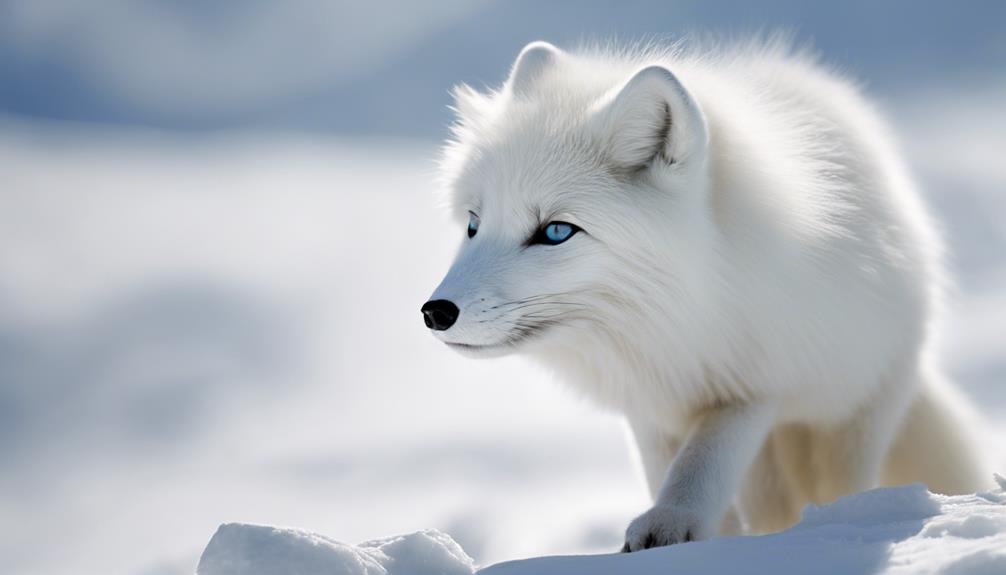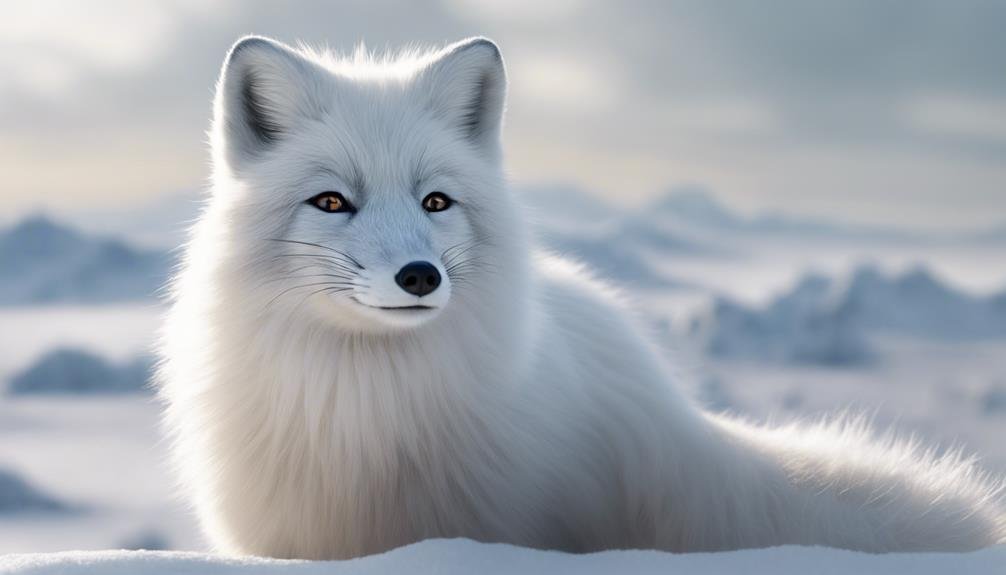What Special Adaptations Make Arctic Foxes Masters of the Ice?
Have you ever wondered how the Arctic fox not only survives but thrives in the harsh Arctic environment?
Arctic Fox Adaptations: A Masterclass in Survival
In the vast expanse of the Arctic, the Arctic fox showcases a remarkable array of adaptations that make it a true master of the ice. From its thick, insulating fur to its compact size and keen hunting skills, every aspect of the Arctic fox’s being is finely tuned to excel in its icy realm. This creature’s ability to change its fur color with the seasons, its exceptional hearing to locate prey under the snow, and its compact body for conserving heat are just a few examples of the intricate adaptations that help it endure in one of the harshest landscapes on Earth.
Unraveling the Tale of Arctic Fox Survival
As we delve deeper into the adaptations of the Arctic fox, we uncover a fascinating story of evolution and resilience. Each adaptation, whether it’s the furry paws that act as natural snowshoes or the ability to go for extended periods without food, is a testament to the fox’s ability to thrive in a challenging environment. By understanding these adaptations, we gain insight into the complex web of survival strategies that have allowed the Arctic fox to not only survive but flourish in the unforgiving Arctic wilderness.
Intricacies of Arctic Fox Adaptations
Bold and resourceful, the Arctic fox embodies the epitome of adaptation in the icy tundra. Its keen senses, specialized fur, and efficient hunting techniques all work in harmony to ensure its survival in a landscape where every detail is crucial. By studying the special adaptations of the Arctic fox, we unlock a treasure trove of insights into nature’s ingenuity and the remarkable ways in which animals can thrive in even the most extreme environments.
Key Takeaways
- The Arctic fox has a compact body shape and thick fur that help it withstand the extreme cold of the Arctic environment.
- Its camouflage strategies and winter survival tactics are crucial in enhancing its ability to thrive in challenging conditions.
- Through a combination of physical and behavioral adaptations, the Arctic fox demonstrates exceptional resilience and adaptability in navigating the frozen tundra.
Unique Arctic Fox Physical Features
Thick Fur for Insulation
In the harsh Arctic winters, Arctic foxes rely on their thick fur as a crucial survival tool. This dense fur acts as a protective barrier, trapping heat close to the fox’s body and preventing it from escaping into the icy surroundings. It’s like having a natural winter coat that keeps them warm and cozy in the frigid environment.
Bushy Tail as a Heat Preserver
The bushy tail of the Arctic fox isn’t just for looks—it serves a vital purpose in helping them survive the extreme cold. When the fox curls up to rest, its bushy tail wraps around its body, acting as a heat preserver. It’s like having a built-in blanket that keeps them snug and comfortable in the icy landscape.
Efficient Body Warmth Conservation
With small, rounded ears and short legs, the Arctic fox is well-equipped to conserve body warmth efficiently. These physical attributes work together to help the Arctic fox maintain its body temperature in one of the coldest habitats on Earth. It’s like having a unique set of features tailored specifically for thriving in the Arctic wilderness.
Arctic Fox Camouflage Strategies
Arctic Fox Coat Color Adaptation
Arctic foxes showcase incredible camouflage strategies with their white or blue-gray coats, perfectly blending into the snowy Arctic tundra. Their unique ability to change coat colors from white in winter to brown or gray in summer is crucial for their survival. This adaptation allows Arctic foxes to remain undetected by both prey and predators, giving them an advantage in hunting and avoiding danger.
Stealthy Movements
The color change in their fur helps Arctic foxes move stealthily through their environment, approaching targets without being noticed. By matching their fur to the surrounding landscape, these foxes can easily navigate the harsh Arctic terrain with minimal visibility.
Survival Advantage
The camouflage provided by their coat color change is a vital advantage in the unforgiving Arctic environment, where visibility is limited. This adaptation enhances their survival by allowing them to blend in seamlessly with the snow-covered surroundings.
Key Adaptation for Arctic Environment
The ability of Arctic foxes to change coat colors is a key adaptation for their survival in the Arctic tundra. It helps them survive in extreme conditions by staying hidden from both prey and predators, ensuring their success in the challenging Arctic landscape.
Arctic Fox Winter Survival Tactics

Arctic foxes have mastered the art of survival in the harsh winter conditions of the Arctic through a combination of physical and behavioral adaptations. Let’s delve into their remarkable tactics:
Thick Winter Coat:
The thick winter coat of Arctic foxes serves as a powerful insulator against the freezing temperatures, keeping them warm and protected from the cold winds.
Small Rounded Ears:
Their small rounded ears aren’t just a cute feature but also play a crucial role in reducing heat loss, helping them preserve body heat efficiently.
Furry Paws:
Arctic foxes’ furry paws with thick hair aren’t just for looks; they provide excellent traction on icy surfaces, allowing these agile creatures to navigate the slippery terrain with ease.
Compact Bodies:
Their compact bodies are well-adapted for conserving body heat, ensuring that minimal energy is wasted in maintaining their internal temperature in the frigid Arctic environment.
Dense Fur:
With their dense fur, Arctic foxes are well-equipped to withstand the extreme cold, as it helps trap heat close to their bodies, acting as a natural thermal insulator.
Behavioral Adaptations:
During the brutal Arctic winters, Arctic foxes exhibit smart behavioral adaptations such as burrowing in snow or ice to seek shelter from the harsh weather conditions, showcasing their resourcefulness in finding protection against the elements.
Arctic foxes truly are marvels of adaptation, utilizing a combination of physical features and clever behaviors to thrive in one of the most challenging environments on Earth.
Arctic Fox Hunting Techniques
Adapting Camouflage for Successful Hunting
The Arctic fox, with its white winter coat blending seamlessly into the snowy landscape, utilizes this natural camouflage to stalk and ambush its prey effectively. This adaptation allows the Arctic fox to move undetected, increasing its chances of securing a meal in the harsh Arctic environment.
Utilizing Keen Senses for Tracking
Equipped with sharp senses of sight, smell, and hearing, Arctic foxes rely on these abilities to track down rodents, birds, and fish. Their acute senses aid in pinpointing the location of potential prey, giving them an advantage in the hunt for essential nutrients in the unforgiving Arctic conditions.
Scavenging for Survival
Arctic foxes demonstrate resourcefulness by scavenging leftovers from larger predators like polar bears. This scavenging behavior enables them to capitalize on available food sources, supplementing their diet and increasing their chances of survival in a competitive Arctic ecosystem.
Adapting Diet for Sustenance
In times of scarcity, Arctic foxes showcase their flexibility by including vegetables in their diet. This adaptability allows them to sustain themselves when traditional prey is scarce, demonstrating their ability to adjust and thrive in challenging conditions.
Stealth, Speed, and Precision in Hunting
To secure prey effectively, Arctic foxes combine stealth, speed, and precision in their hunting strategies. By moving quietly and swiftly, they increase their chances of catching fast-moving prey like birds and rodents, showcasing their agility and prowess as skilled predators in the Arctic landscape.
Arctic Fox Behavioral Adaptations

Arctic Fox Behavioral Strategies for Survival
- Stealthy Hunting Tactics: Arctic foxes employ stealthy hunting tactics, utilizing their white fur to blend seamlessly with the snowy surroundings. This camouflaged approach allows them to sneak up on prey and increase their hunting success.
- Adaptive Diet Patterns: Arctic foxes showcase adaptive diet patterns that vary based on food availability in their challenging environment. This flexibility ensures their survival even when food sources fluctuate, showcasing their resilience.
- Group Survival Tactics: Arctic foxes exhibit social behaviors geared towards group survival. By cooperating with fellow foxes, they enhance their ability to secure resources and defend against predators effectively, showcasing the power of teamwork in the harsh Arctic environment.
Frequently Asked Questions
What Are 5 Adaptations of a Arctic Fox?
What unique adaptations do foxes have for survival in snowy landscapes?
What is the special feature of Arctic foxes in snowy environments?
What role does the arctic fox’s tail play in its survival in the harsh Arctic environment?
How Do Arctic Foxes and Walruses Share Similar Adaptations for Surviving the Harsh Arctic Environment?
Arctic foxes and walruses face extreme cold, relying on insulation and resourceful foraging to thrive. Both species have thick layers of fat and fur or blubber to retain warmth. Additionally, arctic walrus adaptations include using tusks for mobility on ice, while arctic foxes develop winter coats for camouflage in snowy environments.
Conclusion
To sum up, the Arctic fox showcases a remarkable set of special adaptations tailored for its survival in the harsh Arctic environment.
With its compact body shape and thick fur, the Arctic fox is well-equipped to endure the extreme cold.
Its camouflage strategies and winter survival tactics further enhance its ability to thrive in challenging conditions.
Through a combination of physical and behavioral adaptations, the Arctic fox exemplifies exceptional resilience and adaptability in navigating the frozen tundra, securing its place as a true survivor of the Arctic wilderness.


